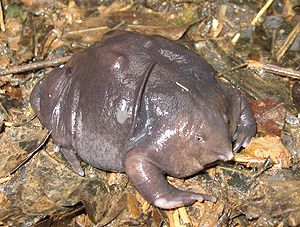Nasikabatrachus sahyadrensis
| Nasikabatrachus sahyadrensis | ||||||||||||
|---|---|---|---|---|---|---|---|---|---|---|---|---|

Nasikabatrachus sahyadrensis |
||||||||||||
| Systematics | ||||||||||||
|
||||||||||||
| Scientific name | ||||||||||||
| Nasikabatrachus sahyadrensis | ||||||||||||
| Biju & Bossuyt , 2003 |
Nasikabatrachus sahyadrensis is a species of frogfish thatoccursin the Western Ghats in southwest India. It was only discovered in 2003 and together with its sister species Nasikabatrachus bhupathi, described in 2017, represents the own family Nasikabatrachidae within the amphibians .
Surname
The scientific name is derived from the Sanskrit word nasika for nose, the Greek word batrachus for frog and Sahyadri , the native name of the mountain in which it occurs.
Appearance
Nasikabatrachus sahyadrensis has a broad and about seven centimeters long, puffy-looking body of purple-violet color and a head shape very unusual for a frog. Above all, the pointed snout, which in connection with the tiny eyes is strongly reminiscent of a mole , is out of the ordinary. You can also feel a certain resemblance to a human nose.
Way of life
Most of the year the frog lives hidden in the ground, from which it apparently only emerges for a period of two weeks during the monsoons to reproduce. This hidden way of life is likely to be the reason why it has remained hidden from zoologists for so long. It feeds on termites underground . The pointed snout is particularly suitable for this. The tadpoles of this species of frog have adapted to fast flowing waters. They graze on algae on the steep slopes of waterfalls, and they are supported by a mouth shaped like a strong suction cup.
ancestry
According to genetic studies, the species separated from the other species of the frog auger 100 million years ago and can therefore be considered a living fossil . Up until this time, the Seychelles , the Indian subcontinent and Madagascar still formed a contiguous land mass. The species is believed to be the last survivor of the Nasikabatrachidae family. The closest related family is that of the Seychelles frogs (Sooglossidae), whose members are found in the Seychelles. However, some authors classify Nasikabatrachus directly in the Sooglossidae family and do not give it a separate family status .
discovery
Nasikabatrachus sahyadrensis was found by an Indian - Belgian research team led by Franky Bossuyt (Vrije Universiteit Brussel) and SD Biju (Tropical Botanic Garden and Research Institute Palode, India). The discovery became known in October 2003.
literature
- SD Biju, Franky Bossuyt: New frog family from India reveals an ancient biogeographical link with the Seychelles. In: Nature. Issue 425, pages 711–714, October 16, 2003 ( online ; PDF; 913 kB)
Individual evidence
- Jump up ↑ S. Jegath Janani, Karthikeyan Vasudevan, Elizabeth Prendini, Sushil Kumar Dutta and Ramesh K. Aggarwal. 2017. A New Species of the Genus Nasikabatrachus (Anura, Nasikabatrachidae) from the eastern Slopes of the Western Ghats, India. Alytes. 34: 1-19.
Web links
- Nasikabatrachus sahyadrensis in the endangered Red List species the IUCN 2009. Posted by: SD Biju, of 2004.
- Information and a picture of Nasikabatrachus sahyadrensis at www.edgeofexistence.org (Engl.)
- Report at www.innovations-report.de
- Species portrait at Amphibiaweb (Engl.)
- Amphibian Species of the World (Engl.)
